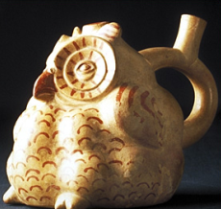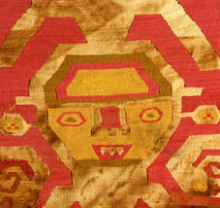explore
Coastal Desert - Religion

Through ceremonies, societies celebrated their relationships with nature. Ancient Andean potters and weavers created colourful and exquisitely crafted objects reflecting the natural world. Ancient peoples revealed much about their beliefs, rituals, gods, rulers, flora, fauna, architecture and many other aspects of their lives. Designs from pots and textiles were also depicted on architecture and metalwork.
Image: Moche ceramic stirrup vessel, c. A.D. 100 - 500. This pot, an effigy of an owl, is a fine example of the realistic style of Moche ceramic arts. It also demonstrates the importance of the natural world to coastal artists, providing both subject and inspiration. G83.1.161

During Chimú times, the moon goddess Si was the chief divinity, believed to control the weather, the growth of crops and the tides of the ocean. She was considered more powerful than the sun because she appeared both night and day; especially as to people living in a dry desert, the sun was a tormentor which brought blistering heat and wilted crops.
The sea, Ni, was also an important divinity who was asked for fish and protection from drowning.
Image: This Chimú textile depicts a figure wearing a crescent headdress - a common form of elite headgear among the cultures of the north coast - which may represent a phase of the moon. T85.0518